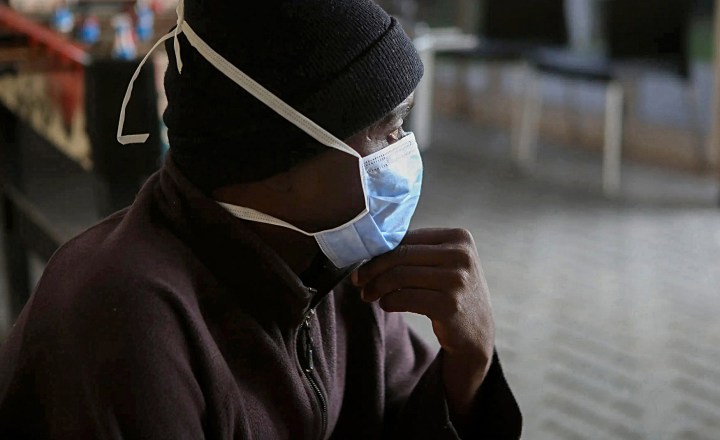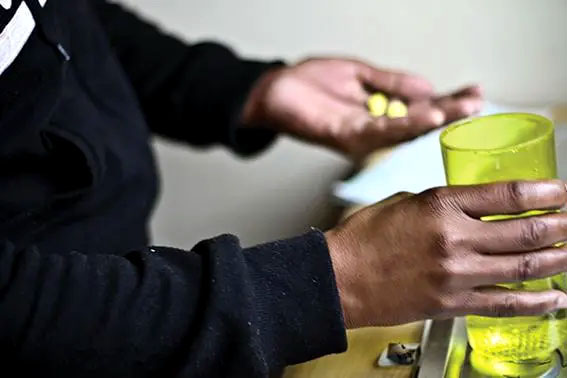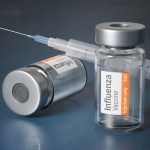SPOTLIGHT
TB contact tracing helps save lives — this is how it works in SA

Tracing the close contacts of people ill with tuberculosis and offering them TB preventive therapy is part of South Africa’s strategy to fight the disease.
Globally, an estimated 850,000 lives could be saved by 2035 if short-course tuberculosis (TB) preventive therapy is provided to people living with HIV and contacts of individuals newly diagnosed with TB, a recent analysis published in the journal The Lancet Global Health found. And 700,000 of those lives saved would be among children aged 15 years and younger.
The study, co-authored by researchers from Johns Hopkins University, the Aurum Institute (an NGO), and the global health agency Unitaid, also found the combined intervention of contact tracing and TB prevention to be broadly cost-effective for household contacts of all ages. The impact was particularly high among children under the age of five who face a higher risk of dying of TB.
“Although progress has been made in preventing TB among people living with HIV, we’ve lagged behind in keeping family members — especially children — free of the disease when a parent becomes sick,” said Professor Gavin Churchyard, group chief executive officer of the Aurum Institute, in a statement. “This new study, we hope, provides the evidence needed to massively scale up the use of TB preventive treatment among those individuals at risk of developing TB.”

In 2021, tuberculosis accounted for 56,000 deaths in South Africa. The disease remains the leading cause of death in the country. (Photo: Madelene Cronje)
The findings should bolster the implementation of South Africa’s recently updated guidelines for the treatment of TB infection. As Spotlight has reported, those guidelines endorse casting the net wider when it comes to contact tracing and the provision of TB preventive therapy. They also endorse the use of short-course TB preventive therapy, although access to such short-course therapies, for now, remains limited in the public sector.
Read more in Daily Maverick: National TB Indaba reveals way forward for retaking control of tuberculosis after Covid-19 setbacks
According to the most recent World Health Organization estimates, about 304,000 people fell ill with TB in South Africa in 2021 and 56,000 died of the disease. The findings suggest that effective contact tracing could contribute to bringing these numbers down more quickly than would otherwise be the case. But does South Africa have an effective contact tracing system and how is contact tracing actually done in the country?
What is contact tracing?
Professor Martie van der Walt, director of the Tuberculosis Platform at the South African Medical Research Council, says TB is a slowly developing disease, and a person can transmit the bacteria to others around them before the signs and symptoms become acute.
“Secondly, over the duration of the disease, there will be many people with which a person has regular contact, such as church groups, colleagues, driving club and classmates,” she says. “A person with TB has the same social networks as anyone else, and to fully prevent transmission of TB, as many as possible individuals in the social networks of a person with TB should be tested for TB.”
Dr Lucy Connell, the TB programme head at Right to Care (an NGO), says contact tracing for TB is a series of activities that should be triggered for each person who is diagnosed with TB as soon as they start TB treatment. “We refer to this person as the ‘index patient,’” she says. “The aim of contact tracing is to find more people with undiagnosed TB and start them on TB treatment to optimise their health and stop further transmission of TB.”
She says TB contact tracing begins in the health facility where the person receives their TB treatment with an explanation of how TB is transmitted and helping the patient identify who among their social networks could have come into close contact with them in the preceding months. Often, she says, the focus is on household contacts because we tend to spend most time indoors with household members.
But while tracing had mainly been aimed at households until this year, South Africa’s new guidelines have shifted the focus to a broader definition of people that have had “significant TB exposure”.

South Africa’s recently published guidelines for the treatment of tuberculosis infection have been welcomed by several experts. (Photo: TAC Archive / Spotlight)
According to the guidelines, “significant exposure is to an adult or adolescent with pulmonary TB who has shared the same enclosed space for one or more nights, or, for frequent or extended daytime periods”. This could be at a school, crèche, tavern, church or on a bus or taxi during the three months before the index patient (the first patient to be diagnosed) started TB treatment.
Once identified, an effort is made to reach these people and screen them for TB, either by asking them to come into the clinic or by conducting household contact tracing. Public awareness is very important.
“People need to know that if they have been in contact with someone with TB, they should go to their closest facility without delay,” says Connell, adding that if the health worker assesses their contact as a close contact, they should have a TB test right away, whether they have TB symptoms or not.
Who does contact tracing?
Dr Ntokozo Mzimela, a lecturer in integrated pathology at the Faculty of Health Sciences at Nelson Mandela University, explains that ward-based primary healthcare outreach teams (commonly referred to as outreach teams) are responsible for contact tracing. These teams consist of a professional nurse (assigned as team leader) who supervises health promotion practitioners and community healthcare workers.
She says that according to the TB Screening and Testing Standard Operating Procedure published in June 2022, community healthcare workers conduct the actual contact tracing and refer patients for results.
“They work in collaboration with nurses at the health facility and other members of the outreach team. The exact process and timeline may vary depending on [the] specific region or municipality. Ideally, this should be done within 14 days of identifying the index TB case,” she says. Mzimela says each team is linked to a health facility and provides services to catchment areas of approximately 1,500 households.
According to Foster Mohale, the spokesperson for the National Department of Health, provinces report that they do not have 100% coverage when it comes to ward-based outreach teams.
Community healthcare workers are not always employed by the government and in some instances contact tracing services are provided by NGOs. Portia January, a supervisor at In the Public Interest, an NGO working in Klipfontein, Cape Town, says their organisation gets a list of index patients from a day hospital. The number of index patients ranges between 10 and 20.
“After we have received the list, we go to the houses to find the contacts of the patients and we do the screening and [explain] why it is important that we contact them and screen them. [We] help the index patient to disclose their TB status where there are disclosure challenges,” she says.
January says they work in pairs.
“Because we wear uniforms, it is easy for people in the area to identify us. Some even call us TB nurses. To avoid stigma for the index patients and their contacts, we try and visit a few more houses in the area to do checks for other lifestyle diseases. So that when we go to the index patients, other people won’t know why we are there,” she says.
She says one of the most difficult things about their job is when someone dies.
“You know TB is preventable and curable. So when someone dies, we really feel bad. We ask ourselves so many questions: what did we do wrong, where did we go wrong, was our counselling not good enough? That is why when we go there, we make sure that we look at the circumstances of the family. Do they have food and all? [We] try [to] do our best,” she says.
In all this, Mohale points out, people with TB also have a role to play.
“It is the responsibility of the patient to inform close contacts and ensure that they go to clinic for screening and testing, especially if the patient is an adult,” he says. “Otherwise, community health workers are responsible for tracing, screening, collection of specimen for testing, and referral to clinic/CHC.”
Numbers and focus
How much contact tracing is actually being done in South Africa is not clear. Mzimela says, “Currently we do not have statistics available.” She does, however, say that new indicators have been developed by the National Department of Health and that these will hopefully be available soon on the District Health Information System (DHIS).

Between April and June 2023, the health department’s District Health Information System shows that community outreach services screened 272,964 TB contacts. (Photo: Nthusang Lefafa / Spotlight)
The chief director for TB control and management in the National Department of Health, Dr Norbert Ndjeka, says the department did indeed start collecting TB contact tracing data on the DHIS in April this year.
“Between April and June, DHIS shows that community outreach services screened 272,964 TB contacts. If they keep this momentum, they will have screened over 800,000 contacts by the end of the year,” he says.
According to our back-of-the-envelope calculations, this works out to around five to six people traced for every person diagnosed with TB.
Read more in Daily Maverick: Community-based testing boosts diagnosis of infectious TB, study finds
“In reality,” Connell says, “outreach teams often have many tasks, and TB contact tracing does not receive enough focus.” Along similar lines, Van der Walt suggests that contact tracing has not received much attention when done by clinic staff. “This is costly and time-consuming,” she says, “but mostly tracing is being done by NGOs on behalf of clinics.”
As pointed out by several experts interviewed by Spotlight, TB prevention and control (including contact tracing) is resource-intensive and requires staff to do the work. Community healthcare workers often have many other job functions in addition to having to trace contacts, and the public healthcare system in South Africa is often understaffed. Even so, the Lancet Global Health findings suggest that investments in these areas are worth making.
“The imperative for TB prevention is clear,” says Vincent Bretin, the director of results at Unitaid.
“This cost-effectiveness analysis proves that preemptively reaching all at-risk individuals — even when it requires the logistical hurdles of going into communities to find those who may not be actively seeking care — is not just ethically sound. It is a smart investment capable of making an enormous impact on the fight to end TB worldwide.” DM
This article was published by Spotlight — health journalism in the public interest.


















 Become an Insider
Become an Insider
Comments - Please login in order to comment.